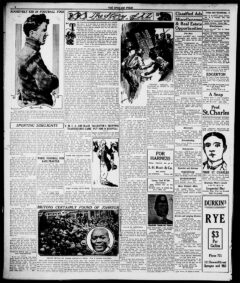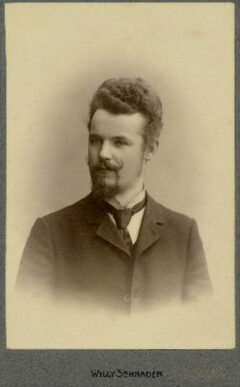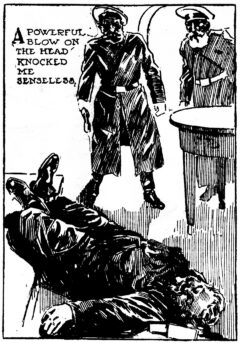The brutality of the 1905 Revolution and the subsequent punitive expeditions in the Baltic provinces of the Russian Empire saw frequent coverage in European and American newspapers, even after the worst of the repressions were over.
As some of the revolutionaries who were tortured escaped to western Europe, they related to journalists vivid descriptions of their prison experiences. The stories circulated far and wide. A newspaper in London might publish an account that would be picked up by other British publications, and from there the story would hop across the oceans to Canada, the United States, and even Australia and New Zealand. And that was just in the English-speaking world.

For me, one particular story stands out: An eyewitness account supposedly told by an Estonian imprisoned and tortured in Latvia.
The story was first published in the London Daily News in August 1908, but I initially came upon it as an illustrated five-part series reprinted during the second half of October 1908 in the daily Spokane Press in Washington state. “The Story of XZ: An Expose of Cruelty in Russian Prisons” offered readers gruesome details of torture and death for those who were suspected of resisting the authorities.1
XZ was in fact Eduards Bīriņš, a revolutionary who would go on to a career as a journalist and diplomat, serving as Latvia’s first consul general in Great Britain before he returned to his homeland in 1927. Bīriņš spent the next decades until his death in 1971 in relative obscurity. Only in the past 12 years has his story, helped by the discovery of his diaries, caught the attention of historians.2
It appears few if any newspapers gave “The Story of XZ” quite the artistic treatment seen in the Spokane daily, but several ran excerpts or longer, edited versions.3
The Spokane newspaper introduced its presentation with this:
The Press herewith begins the publication of a remarkable story. It is the tale of a man for two years a prisoner in Russia. It tells the horrors of the torture chamber with a fidelity possible only for one who has undergone its terrors.
For obvious reasons the name of the writer is concealed, but he is known, and his story has been investigated by the London Express4, the editor of which is convinced that he has told the truth.
XZ is an Esthonian5, a native of the Baltic provinces, and an educated man. As will be seen from his narrative, he was arrested rather less than two years ago, nearly a year after the outbreaks in the Baltic provinces.

Why XZ was referred to as Estonian remains unclear to me. Bīriņš was born to ethnic Latvian parents, according to biographical data tracked down by historian Dzintars Bušs.6 If describing him as Estonian was part of a ruse meant to throw off czarist agents who might be looking for Bīriņš, it was not very clever. The details provided by “XZ” — down to the location of his family home, the first names of two of his brothers, and the identities of people he encountered in various prisons — were accurate enough that authorities back in the homeland could easily have figured out who he was. For that matter, “XZ” as a pseudonym provided little cover.
The first part of XZ’s story told of his capture. He was arrested at the family home, “Cāļi” in Vecsvirlauka parish (in the newspaper, this was transliterated as Tsalle), on Sept. 4, 1906, along with two of his brothers, a hired hand, and a guest. The home was about 10 kilometers southeast of Jelgava. XZ worked as a typesetter for the H. Hempel & Co. printing business in Rīga. The police official who arrested him initially accused XZ of printing revolutionary proclamations and also claimed he was editor of Cīņa, the newspaper of the Latvian Socialdemocratic Workers Party.
The police official was mostly wrong. Bīriņš was a member of the rival Latvian Socialdemocratic Union (Latvijas Sociāldemokrātu Savienība). In the Hempel print shop on Rīga’s Vaļņu Street, he may well have had a hand in producing proclamations, but he also worked on the radical arts and literature journal Pret Sauli.
XZ was kept in custody for about seven months. He was taken first to Jelgava (referred to by the old name Mitava in the newspaper story) and then to Rīga, where he was interrogated by the infamous Ivan Gregus, chief of the secret police. From there, XZ was sent to Lielvārde (Lindvarden) and then to Ogre (Ogren), until, badly hurt, he was transferred back to Rīga and the hospital in the central prison.

In each location, XZ was a victim of or witness to torture. Among those he mentioned as murdered or executed were prisoners such as Arnolds Mārtinsons (Adolfs Millers), Jānis Jirgens, Amalia Kreger, and Pēteris Pridriksons.
At the time the newspaper story appeared in 1908, Bīriņš may have held some contempt for Eduards Baumanis, a young man who had been caught with a cache of documents that led to the downfall of the Latvian Socialdemocratic Union. Baumanis reportedly cracked during his interrogation and revealed the identities of many of his comrades, including Bīriņš and his brothers.
“As soon as we were brought to the premises of the Secret police,” XZ said, “the chief, Gregus, ordered me to be brought to his cabinet, and pointing to the man who had denounced me, Edward Baumann, asked me if I knew him. I answered in the negative, and immediately a blow was aimed at my head from behind.”
Later, in his memoirs, Bīriņš described meeting a broken and tearful Baumanis in the prison hospital. He described with some sympathy how the 18-year-old told him he had recanted his testimony and still hoped his mother could intervene with authorities and save him from the death penalty.
“I stroked his thick, black hair,” Bīriņš recalled. “I will never forget his dark, tearful gaze. With nothing more to say to him, I shook his hand and parted forever.”7 Despite having aided the secret police, Baumanis was executed in March 1908.
In April 1908, XZ related, he was temporarily released from prison on 500 rubles bail. However, before he could be brought to trial8 along with the printer Hugo Hempel and other members of the Latvian Socialdemocratic Union, Bīriņš went into exile, eventually surfacing in London. His story, told both to members of the parliament and to the press, helped swing public opinion against Russia and, specifically, against a planned visit there by British King Edward VII.
XZ’s story was not the only one to emerge from the post-Revolution repressions. A month before his account, the story of what Mary Verdin had endured and witnessed also shocked readers.9
Tales of the torture of prisoners in Rīga and elsewhere in the Russian Empire were compiled in 1909 by the anarchist and philosopher Peter Kropotkin and published in a book, The Terror in Russia: An Appeal to the British Nation.10
“(I)t is above all at Riga that torture flourished,” he wrote, noting in particular one case that “was also mentioned in all the leading dailies and not contradicted.”11
1. The first installment appeared in The Spokane Press on October 20, 1908, and the series continued until October 24, 1908.
2. The most comprehensive discussion of the life and career of Eduards Bīriņš is by Dzintars Bušs, “Eduards Bīriņš – Viens no pirmajiem Latvijas diplomātiem,” Latvijas Vēstures Institūta Žurnāls 2012:3, 124-150. An abbreviated version appeared as a newspaper article, Dzintars Bušs, “Kā aprāvās enerģiskā Latvijas diplomāta Bīriņa karjera,” Latvijas Avīze, April 5, 2003. Some of Bīriņš’ memoirs, with commentary from historian Līga Lapa, were published in 10 installments from 2006 to 2012 beginning with Kaspars Kļaviņš, “Eduarda Bīriņa atmiņas,” Latvijas Vēstures Institūta Žurnāls 2006:3, 115–138, and concluding with Eduards Bīriņš, “Manas atmiņas,” Latvijas Vēstures Institūta Žurnāls 2012:3, 112-122. See also Jānis Andrups, “Lielbritanijas latviešu vēsture,” in Inese Auziņa-Smita, ed., Latvieši Lielbritanijā (London: Latviešu nacionālā padome Lielbritanijā, 1995), pp. 30-31.
3. See, for example, a Sydney, Australia, weekly’s coverage, “Ghastly Prison Scenes” The Arrow, 10 Oct 1908; how a Canadian daily failed to mention the London newspaper in “A Torture Room,” The Winnipeg Tribune, October 16, 1908, p. 7; or the lengthy, but edited, version printed in a New Zealand daily, “A Ghastly Record,” New Zealand Times, September 29, 1908. A number of newspapers in the United Kingdom also offered versions of the London paper’s original report.
4. The Spokane Press may have confused the London Express and the London Daily News.
5. In this period, Estonia was sometimes spelled Esthonia.
6. In his memoirs, according to what was published in Latvijas Vēstures Institūta Žurnāls, Bīriņš corrected the London Daily News text to state that he was Latvian, but in fact the British paper had referred to him as Estonian.
7. Eduards Bīriņš, “Manas atmiņas,” Latvijas Vēstures Institūta Žurnāls 2009:2, p. 131.
8. More than 50 members of the Latvian Socialdemocratic Union were tried in 1908 for various offenses thanks largely to the testimony of Eduards Baumanis and the documents with which he was found. Bīriņš was one of a handful of defendants who did not end up in court because they had fled the country. See, for example, “Tiesas nodaļa,” Liepājas Atbalss, June 17, 1908, p. 3.
9. See, for example, a story in a Scottish daily, “In the Torture Chamber,” Dundee Evening Telegraph, July 31, 1908, p. 2.
10. Peter Kropotkin, The Terror in Russia: An Appeal to the British Nation (London: Methuen & Co., 1909).
11. Kropotkin, p. 27.
Accessed on 16 Apr 2024.
The article may be found online at https://straumanis.com/2018/story-of-xz/.
